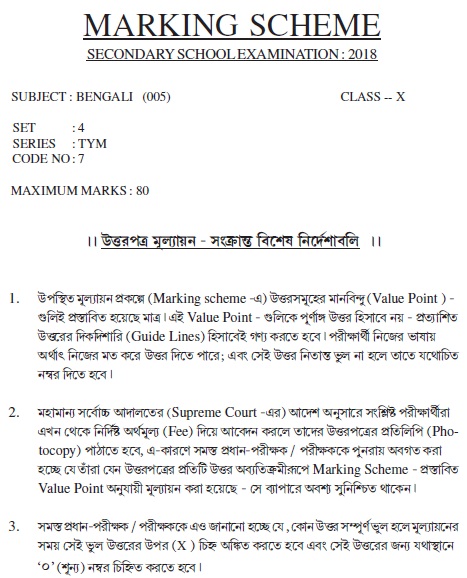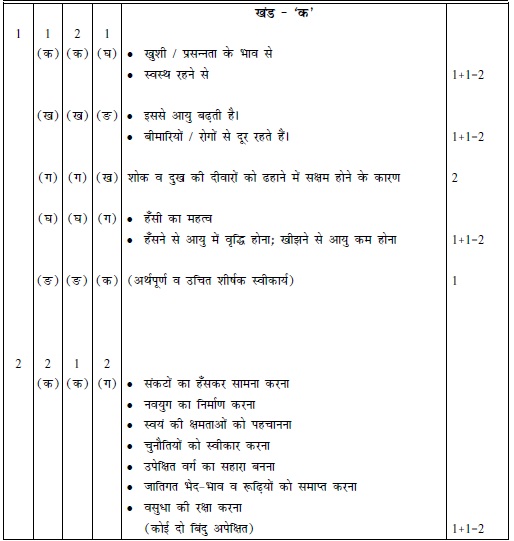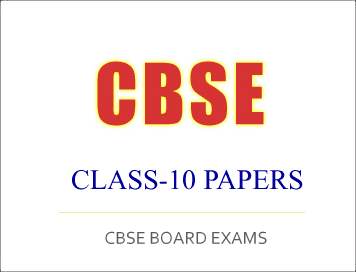CBSE PORTAL : CBSE Class-10 Exam 2018 : Marking Scheme, Bengali | |
- CBSE Class-10 Exam 2018 : Marking Scheme, Bengali
- CBSE Class-10 Exam 2018 : Marking Scheme, Hindi (Course A - B)
- CBSE Class-10 Exam 2018 : All India Scheme Question Paper-Elements of Book Keeping and Accountancy
- CBSE Class-10 Exam 2018 : All India Scheme Question Paper-Banking & Insurance
- (Download) CBSE: Class XII Banking Question Paper - 2018
- (Download) CBSE: Class XII Electrical Machines Question Paper - 2018
| CBSE Class-10 Exam 2018 : Marking Scheme, Bengali Posted: 24 Jul 2018 04:19 AM PDT CBSE Class-10 Exam 2018 : Marking SchemeQuestion Paper, BengaliCBSE Class-10 Exam 2018 : BengaliMARKING SCHEME SECONDARY SCHOOL EXAMINATION ---- 2018 SUBJECT : BENGALI (005) CLASS -- X SET : 4 SERIES : TYM CODE NO. : 7 Click Here to Download Full PaperCourtesy: CBSE |
| CBSE Class-10 Exam 2018 : Marking Scheme, Hindi (Course A - B) Posted: 24 Jul 2018 04:07 AM PDT CBSE Class-10 Exam 2018 : Marking SchemeQuestion Paper, Hindi (Course A-B)CBSE Class-10 Exam 2018 : Hindi (Course A)सेकेंडरी स्कूल परीक्षा सामान्य निर्देश: मूल्यांकन करते समय कृपया निम्नलिखित निर्देशों के प्रति सावधनी बरतिए। विशेष निर्देश: माननीय सर्वोच्च न्यायालय के आदेशानुसार परीक्षार्थी तय शुल्क देकर उत्तर-पुस्तिका की फोटोकापी प्राप्त कर सकते हैं। परीक्षक यह सुनिश्चित करें कि उन्हें प्रत्येक प्रश्न की अंक 1. परीक्षकों के साथ जब तक प्रथम दिन वैयक्तिक अथवा सामूहिक रूप से अंक-योजना पर भली-भाँति विचार-विनिमय नहीं हो जाता तब तक मूल्यांकन आरंभ न कराया जाए। 2. अंक योजना का उद्देश्य मूल्यांकन को अधिकाधिक वस्तुनिष्ठ बनाना है। अंक-योजना में दिए गए उत्तर-बिंदु अंतिम नहीं हैं। ये सुझावात्मक एवं सांकेतिक हैं। यदि परीक्षार्थी ने इनसे 3. मूल्यांकन-कार्य अपनी निजी व्याख्या के अनुसार नहीं, बल्कि अंक-योजना में निर्दिष्ट निर्देशानुसार ही किया जाए। 4. प्रश्न के उपभागों के उत्तरों पर र्दाइं ओर अंक दिए जाएँ, बाद में उपभागों के इन अंकों के योग को र्बाइं ओर हाशिये में लिखकर उसे गोलाकृत कर दिया जाए। 5. यदि प्रश्न का कोई उपभाग नहीं है तो उस पर बाईं ओर ही अंक दिए जाएँ। 6. यदि परीक्षार्थी ने किसी प्रश्न का उत्तर दो स्थानों पर भी लिख दिया है और किसी को काटा नहीं हैं तो जहाँ उत्तर अध्कि अच्छा लिखा गया है, उस पर अंक दें और दूसरे को काट दें। 7. प्रश्नों के उत्तर यदि बिंदुओं में अपेक्षित हो, और परीक्षार्थी अपेक्षा से अध्कि बिंदुओं का उल्लेख करे तो सही बिंदु / बिंदुओं पर अंक दें और शेष / अनुपयुक्त बिंदुओं को काट दें। 8. एक ही प्रकार की अशुद्धि पर अंक न काटें। 9. शब्द-सीमा से अध्कि शब्द होने पर भी अंक न काटे जाएँ। 10. प्रायः यह प्रवृत्ति देखी जाती है कि परीक्षक सहानुभूति में 30% अंक प्राप्त करने वाले परीक्षार्थी को 33% अंक देकर उत्तीर्ण कर देते हैं, या कहीं एक अंक केवल इस आधर पर काट लेते हैं कि पूरे अंक नहीं दिए जा सकते। यहाँ यह ध्यान रखना होगा कि मूल्यांकन में संपूर्ण अंक पैमाने - 0 से 80 का प्रयोग अभीष्ट है अर्थात् परीक्षार्थी ने यदि सभी अपेक्षित उत्तर-बिंदुओं का उल्लेख किया है तो उसे पूरे 80 अंक भी दिए जा सकते हैं। 11. उत्तर पुस्तिकाओं का मूल्यांकन करते समय यदि कोई उत्तर पूर्णतः गलत मिलता है तो उस उत्तर पर गलत (X) चिह्नित कर शून्य (0) अंक दिए जाएँ। Click Here to Download Full paperCBSE Class-10 Exam 2018 : Hindi (Course B)सेकेंडरी स्कूल परीक्षा सामान्य निर्देश: मूल्यांकन करते समय कृपया निम्नलिखित निर्देशों के प्रति सावधनी बरतिए। विशेष निर्देश: माननीय सर्वोच्च न्यायालय के आदेशानुसार परीक्षार्थी तय शुल्क देकर उत्तर-पुस्तिका की फोटोकापी प्राप्त कर सकते हैं। परीक्षक यह सुनिश्चित करें कि उन्हें प्रत्येक प्रश्न की अंक 1. परीक्षकों के साथ जब तक प्रथम दिन वैयक्तिक अथवा सामूहिक रूप से अंक-योजना पर भली-भाँति विचार-विनिमय नहीं हो जाता तब तक मूल्यांकन आरंभ न कराया जाए। 2. अंक योजना का उद्देश्य मूल्यांकन को अधिकाधिक वस्तुनिष्ठ बनाना है। अंक-योजना में दिए गए उत्तर-बिंदु अंतिम नहीं हैं। ये सुझावात्मक एवं सांकेतिक हैं। यदि परीक्षार्थी ने इनसे 3. मूल्यांकन-कार्य अपनी निजी व्याख्या के अनुसार नहीं, बल्कि अंक-योजना में निर्दिष्ट निर्देशानुसार ही किया जाए। 4. प्रश्न के उपभागों के उत्तरों पर र्दाइं ओर अंक दिए जाएँ, बाद में उपभागों के इन अंकों के योग को र्बाइं ओर हाशिये में लिखकर उसे गोलाकृत कर दिया जाए। 5. यदि प्रश्न का कोई उपभाग नहीं है तो उस पर बाईं ओर ही अंक दिए जाएँ। 6. यदि परीक्षार्थी ने किसी प्रश्न का उत्तर दो स्थानों पर भी लिख दिया है और किसी को काटा नहीं हैं तो जहाँ उत्तर अध्कि अच्छा लिखा गया है, उस पर अंक दें और दूसरे को काट दें। 7. प्रश्नों के उत्तर यदि बिंदुओं में अपेक्षित हो, और परीक्षार्थी अपेक्षा से अध्कि बिंदुओं का उल्लेख करे तो सही बिंदु / बिंदुओं पर अंक दें और शेष / अनुपयुक्त बिंदुओं को काट दें। 8. एक ही प्रकार की अशुद्धि पर अंक न काटें। 9. शब्द-सीमा से अध्कि शब्द होने पर भी अंक न काटे जाएँ। 10. प्रायः यह प्रवृत्ति देखी जाती है कि परीक्षक सहानुभूति में 30% अंक प्राप्त करने वाले परीक्षार्थी को 33% अंक देकर उत्तीर्ण कर देते हैं, या कहीं एक अंक केवल इस आधर पर काट लेते हैं कि पूरे अंक नहीं दिए जा सकते। यहाँ यह ध्यान रखना होगा कि मूल्यांकन में संपूर्ण अंक पैमाने - 0 से 80 का प्रयोग अभीष्ट है अर्थात् परीक्षार्थी ने यदि सभी अपेक्षित उत्तर-बिंदुओं का उल्लेख किया है तो उसे पूरे 80 अंक भी दिए जा सकते हैं। 11. उत्तर पुस्तिकाओं का मूल्यांकन करते समय यदि कोई उत्तर पूर्णतः गलत मिलता है तो उस उत्तर पर गलत (X) चिह्नित कर शून्य (0) अंक दिए जाएँ। Click Here to Download Full paperCourtesy: CBSE |
| CBSE Class-10 Exam 2018 : All India Scheme Question Paper-Elements of Book Keeping and Accountancy Posted: 24 Jul 2018 01:51 AM PDT |
| CBSE Class-10 Exam 2018 : All India Scheme Question Paper-Banking & Insurance Posted: 24 Jul 2018 01:08 AM PDT |
| (Download) CBSE: Class XII Banking Question Paper - 2018 Posted: 24 Jul 2018 12:42 AM PDT
Question Papers For Board Examinations 2018Class – XIISubject – BankingSubject : Banking Class : XII Year : 2018 General Instructions :
1. Write the full form of ATM. 2. Write the names of any two Mutual Funds. 3. On which side of the Balance Sheet of a Banking Company are ‘Deposits’ shown ? 4. What is ATM PIN ? When is it provided by the bank ? 5. What is meant by ‘Back Office’ of a bank ? 6. What will be the due date for payment of a bill payable three months after date if it is drawn and accepted on 1st January, 2017 ? 7. What is meant by ‘Cash Reserve Ratio’ ? 8. What is meant by a Balance Sheet ? Why is it prepared ? Give the heading of the Balance Sheet of a Banking Company. 9. State the three items appearing under the heading ‘Expenditure’ in the Profit and Loss Account of a Banking Company. 10. Under what major heads are the following categorised while preparing the Balance Sheet of a Banking Company ? 11. What is the difference between a Debit card and a Credit card ? Explain briefly. 12. What is meant by Mobile banking ? How does it differ from using a mobile phone for making payments ? 13. What security arrangements should be made at the entrance gate of a bank branch ? Describe briefly. 14. Distinguish between fixed and floating rates of interest. 15. What do you mean by Repo Rate and Reverse Repo Rate ? 16. What is a Bank Locker ? Explain the process of hiring and operating a bank locker. 17. What is meant by CBS ? Give its full form. What are its benefits for banks and their customers ? 18. What is a Strong Room ? Where should it be located in a bank ? Briefly explain the procedure adopted for taking money out of the strong room. 19. Distinguish between Simple interest and Compound interest. How is compound interest calculated ? What will be the compound interest on < 10,000 for three years @ 5% per annum ? 20. What is Statutory Liquidity Ratio ? Briefly explain the similarities and differences between Statutory Liquidity Ratio and Cash Reserve Ratio. Click Here To Download Full Paper<< Go Back To Main PageCourtesy: CBSE |
| (Download) CBSE: Class XII Electrical Machines Question Paper - 2018 Posted: 24 Jul 2018 12:20 AM PDT
Question Papers For Board Examinations 2018Class – XIISubject – Electrical MachinesSubject : Electrical Machines Class : XII Year : 2018 General Instructions :
Attempt any eleven questions : (a) Which winding in a transformer has more number of turns ? (b) Primary of a power transformer on no load will draw least current from (c) Losses which do not occur in a transformer but do occur in rotating electric machines are (d) A step-up transformer is required to supply (e) Speed control by Ward Leonard method gives uniform speed variation (f) Iron losses in a d.c. machine take place in (g) Which d.c. motor has got the maximum self-retrieving property ? (h) The main function of starter in a 3-phase induction motor is (i) The star delta starter (j) Torque developed by an induction motor is (k) Torque developed by a single-phase induction motor at starting is (l) Starting capacitor of a F.H.P. single-phase motor will have a capacitance of about (m) Short-circuit is used in (n) The bit of a soldering iron is made of (o) The melting point of soft solder will be Click Here To Download Full Paper<< Go Back To Main PageCourtesy: CBSE |
| You are subscribed to email updates from CBSE PORTAL : CBSE, ICSE, NIOS, JEE-MAIN, AIPMT Students Community. To stop receiving these emails, you may unsubscribe now. | Email delivery powered by Google |
| Google, 1600 Amphitheatre Parkway, Mountain View, CA 94043, United States | |





